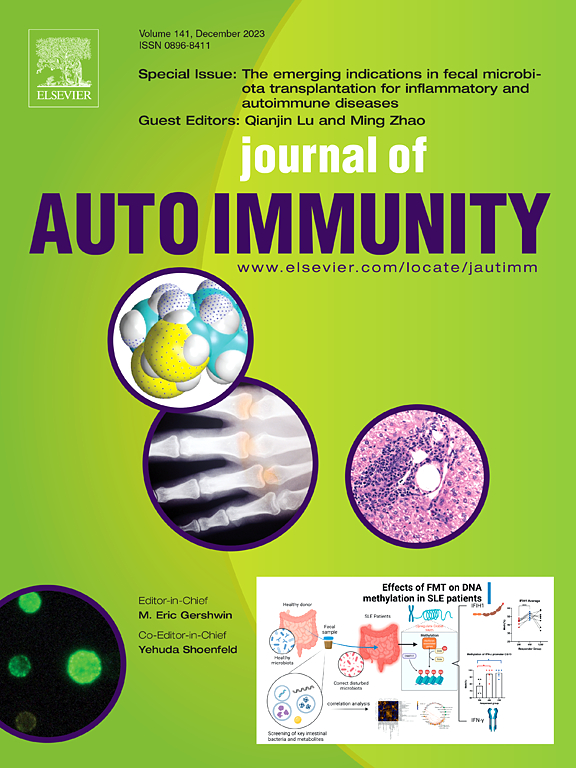Human regulatory B cells suppress autoimmune disease primarily via interleukin-37
IF 7
1区 医学
Q1 IMMUNOLOGY
引用次数: 0
Abstract
Regulatory B cells (Bregs) are crucial for maintaining homeostasis and controlling inflammation. Although interleukin (IL)-10 has been traditionally suggested as the primary suppressive mechanism of Bregs in both mice and humans, the key functional differences between Bregs in these two species, particularly in the context of disease, is still largely unresolved. IL-37, the latest described immunosuppressive cytokine, is produced in humans but not in mice. Herein we identified the characteristics and functions of IL-37-producing Bregs, that naturally exist in human and can be induced by recombinant IL-37 (rIL-37) and/or Toll-like receptor 9 agonist CpG via different mechanisms. rIL-37 alone is sufficient to prompt IL-37, but not IL-10, production and proliferation of Bregs, whereas CpG elicits IL-37 expression in Bregs independently of IL-10, but dependent on HIF-1α which binds on the enhancer/promoter of the IL-37 gene. Functionally, IL-37+ Bregs exhibit superior anti-inflammatory efficacy than IL-37- Bregs in vitro, as well as in psoriasis and colitis models. However, the frequency of IL-37+ Bregs is reduced in patients with psoriasis. Thus, IL-37+ Bregs hold significant therapeutic potential for treating various inflammatory disorders, including psoriasis and colitis.
人类调节性B细胞主要通过白细胞介素-37抑制自身免疫性疾病
调节性B细胞(Bregs)对维持体内平衡和控制炎症至关重要。尽管白细胞介素(IL)-10传统上被认为是小鼠和人类Bregs的主要抑制机制,但这两个物种中Bregs的关键功能差异,特别是在疾病背景下,仍未得到很大程度的解决。IL-37是一种最新发现的免疫抑制细胞因子,它在人类体内产生,但在小鼠体内却没有。在此,我们确定了产生IL-37的Bregs的特征和功能,这些Bregs天然存在于人体内,可以通过不同的机制被重组IL-37 (rIL-37)和/或toll样受体9激动剂CpG诱导。单独IL-37足以促进IL-37而不是IL-10的产生和增殖,而CpG在Bregs中诱导IL-37的表达独立于IL-10,但依赖于与IL-37基因的增强子/启动子结合的HIF-1α。在功能上,IL-37+ Bregs在体外以及银屑病和结肠炎模型中表现出优于IL-37- Bregs的抗炎功效。然而,银屑病患者IL-37+ Bregs的频率降低。因此,IL-37+ Bregs在治疗各种炎症性疾病(包括牛皮癣和结肠炎)方面具有显著的治疗潜力。
本文章由计算机程序翻译,如有差异,请以英文原文为准。
求助全文
约1分钟内获得全文
求助全文
来源期刊

Journal of autoimmunity
医学-免疫学
CiteScore
27.90
自引率
1.60%
发文量
117
审稿时长
17 days
期刊介绍:
The Journal of Autoimmunity serves as the primary publication for research on various facets of autoimmunity. These include topics such as the mechanism of self-recognition, regulation of autoimmune responses, experimental autoimmune diseases, diagnostic tests for autoantibodies, as well as the epidemiology, pathophysiology, and treatment of autoimmune diseases. While the journal covers a wide range of subjects, it emphasizes papers exploring the genetic, molecular biology, and cellular aspects of the field.
The Journal of Translational Autoimmunity, on the other hand, is a subsidiary journal of the Journal of Autoimmunity. It focuses specifically on translating scientific discoveries in autoimmunity into clinical applications and practical solutions. By highlighting research that bridges the gap between basic science and clinical practice, the Journal of Translational Autoimmunity aims to advance the understanding and treatment of autoimmune diseases.
 求助内容:
求助内容: 应助结果提醒方式:
应助结果提醒方式:


